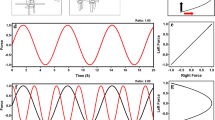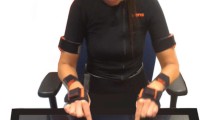Abstract.
Various stability features of bimanual rhythmic coordination, including phase transitions, have been modeled successfully by means of a one-dimensional equation of motion for relative phase obeying a gradient dynamics, the Haken-Kelso-Bunz model. The present study aimed at assessing pattern stability for stationary performance and estimating the model parameters (a, b, and Q) for the stochastic extension of this model. Estimates of a and b allowed for reconstruction of the potential defining the gradient dynamics. Two coordination patterns between the forearms (in-phase, anti-phase) were performed at seven different frequencies. Model parameters were estimated on the basis of an exponential decay parameter describing the relaxation behavior of continuous relative phase following a mechanical perturbation. Variability of relative phase and relaxation time provided measures of pattern stability. Although the predicted inverse relation between pattern stability and movement frequency was observed for the lower tempo conditions, it was absent for the higher tempos, reflecting the influence of task constraints. No statistically significant differences in stability were observed between the two coordination modes, indicating the influence of intention. The reconstructed potential reflected the observed stability features, underscoring the adequacy of the parameter estimations. The relaxation process could not be captured adequately by means of a simple exponential decay function but required an additional oscillatory term. In accordance with previous assumptions, noise strength Q did not vary as a function of movement frequency. However, systematic differences in Q were observed between the two coordination modes. The advantages and (potential) pitfalls of using stationary performance of single patterns to examine the stability features of a bistable potential were discussed.
Similar content being viewed by others
Author information
Authors and Affiliations
Additional information
Received: 12 July 1999 / Accepted in revised form: 14 April 2000
Rights and permissions
About this article
Cite this article
Post, A., Peper, C., Daffertshofer, A. et al. Relative phase dynamics in perturbed interlimb coordination: stability and stochasticity. Biol Cybern 83, 443–459 (2000). https://doi.org/10.1007/s004220000177
Issue Date:
DOI: https://doi.org/10.1007/s004220000177




